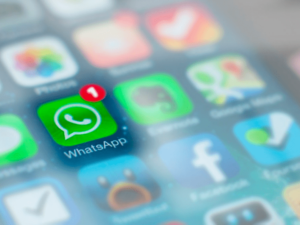Today, there’s an app for just about everything. With all the amazing things our smartphones can do, there is one thing that hasn’t changed since the phone was first developed. No matter how advanced phones become, they are still communication devices — they connect people together.
Though I can’t remember the last time I actually talked to another person live on the phone, I text, email, Tweet, Skype and video message throughout my day. The “job-to-be-done” hasn’t changed — the phone still helps us communicate with people we care about — rather, the interface has evolved to provide options for sending the right message in the right format at the right time.
Clearly, we’re a social species and these tech solutions help us re-create the tribal connection we seek. However, there are other more hidden reasons why messaging services keep us checking, pecking, and duckface posing.
In my book, Hooked: How to Build Habit-Forming Products, I detail a pattern found in products we can’t seem to put down. Though the pattern is found in all sorts of products, successful messaging services are particularly good at deploying the four steps I call, “the Hook,” to keep users coming back.
The Hook is composed of a trigger, action, variable reward, and investment. By understanding these four basic steps, businesses can build better products and services, and consumers can understand the hidden psychology behind our daily technology habits.
Trigger
A trigger is what cues a habit. Whether in the form of an external trigger that tells users what to do next (such as a “click here” button) or an internal trigger (such as an emotion or routine), a trigger must be present for a habitual behavior to occur.
Over time, users form associations with internal triggers so that no external prompting is needed — they come back on their own out of habit. For example, when we’re lonely, we check Facebook. When we fear losing a moment, we capture it with Instagram. These situations and emotions don’t provide any explicit information for what solution solves our needs, rather we eventually form strong connections with products that scratch our emotional itch.
By passing through the four steps of the Hook, users form associations with internal triggers. However, before the habit is formed, companies use external prompts to get users to act. For messaging services, the external trigger is clear. Whenever a friend sends a message via WhatsApp, for example, you see a notification telling you to open the app to check the message.

WhatsApp’s External Trigger
Action
Notifications prompt users to act, in this case tapping the app. The action phase of the Hook is defined as the simplest behavior done in anticipation of a reward. Simply clicking on the app icon opens the messaging app and the message is read.
When the habit forms, users will take this simple action spontaneously to alleviate a feeling, such as the pang of boredom or missing someone special. Opening the app gives the user what they came for — a bit of relief obtained in the easiest way possible.
Variable Reward
The next step of the Hook is the variable rewards phase. This is when users get what they came for and yet are left wanting more.
This phase of the Hook utilizes the classic work of BF Skinner who published his research on intermittent reinforcement. Skinner found that when rewards were given variably, the action preceding the reward occurred more frequently. When forming a new habit, products that incorporate a bit of mystery have an easier time getting us hooked.
For example, Snapchat, the massively popular messaging app that 77% of American college students say they use every day, incorporates all sorts of variable rewards that spike curiosity and interest. The ease of sending selfies that the sender believes will self-destruct makes sending more, shall we say, “interesting,” pics possible. The payoff of opening the app is seeing what’s been sent. As is the case with many successful communication services, the variability is in the message itself — novelty keeps us tapping.

You never know what you’ll see when you open Snapchat
Investment
The final phase of the Hook prompts the user to put something into the service to increase the likelihood of using the service in the future. For example, when users add friends, set preferences, or create content they want to save, they are storing value in the platform. Storing value in a service increases its worth the more users engage with it, making it better with use.
Investments also increase the likelihood of users returning by getting them to load the next trigger. For example, sending a message prompts someone else to reply. Once you get the reply, a notification appears and you’ll likely click through the Hook again.

Growing a “buddylist” on Snapchat is an investment in the platform
Through frequent passes through the Hook, user preferences are shaped, tastes are formed, and habits take hold. Messaging services are here to stay and we’ll most likely see many more iterations on the theme as technological solutions find new ways to bring people together. By understanding the deeper psychology of what makes us click by knowing what makes us tick, we can build better products and ultimately live better lives.
Related Articles
- Schedule Maker: a Google Sheet to Plan Your Week
- Cancel the New York Times? Good Luck Battling “Dark Patterns”
- How to Start a Career in Behavioral Design
- A Free Course on User Behavior
- User Investment: Make Your Users Do the Work
- Variable Rewards: Want To Hook Users? Drive Them Crazy
- The Hooked Model: How to Manufacture Desire in 4 Steps

